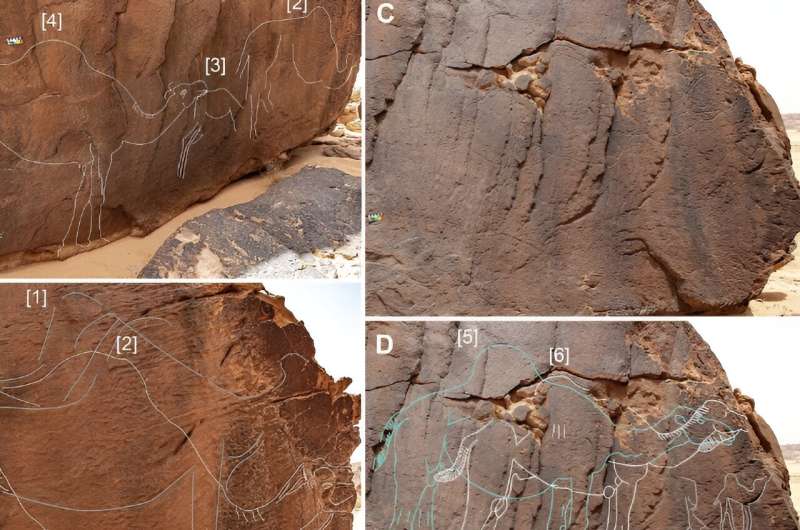October 4, 2023 report
This article has been reviewed according to Science X's editorial process and policies. Editors have highlighted the following attributes while ensuring the content's credibility:
fact-checked
peer-reviewed publication
trusted source
proofread
Life-size images of extinct camel species found carved into stones in Saudi Arabia

An international team of archaeologists has discovered life-size images of an extinct camel species carved into rock formations in Saudia Arabia. In their project, reported in the journal Archaeological Research in Asia, the group discovered the carvings on a rock outcropping in the Nefud desert.
Historians have found it difficult to learn much about the Neolithic era in places like Saudia Arabia due to the harsh environment—the heat, sand and rock are not conducive to preserving traces of people who lived there thousands of years ago. Still, some evidence has been found—in a place called the Camel Site, for example, in a northern part of the country, there are large rocks carved with life-size pictures of camels.
Camel carvings have also been found at other sites in Saudi Arabia; one discovered five years ago in Al-Jouf province has been described as a "parade of life-size camels." In this new effort, the team was studying a rocky outcrop near the southern edge of the Nefud desert.
The outcrop was known to researchers, but it took a closer look to discover artwork etched into its surface by people living in the area thousands of years ago. The new team found several dozen images of a species of camel that has been extinct for thousands of years. Prior research has suggested that such camels once lived all across the Arabian Peninsula. The outcropping has been named Sahout—images were found on three of its formations.
The research team found that the images had been made in layers by different groups of people living during different periods and carving over the images made by those before them—the team could see differences in technique and style. They noted also that the majority of the images were made in crevices likely to preserve them. Also, prior research has shown that other material found in the general area has been dated back to approximately 8,000 years.
In studying the artwork, the researchers found that the images were likely made using stone tools (from chert) and took up to two weeks to create. They also found some evidence that suggested the carvings might have been a communal effort.
More information: Maria Guagnin et al, Before the Holocene humid period: Life-sized camel engravings and early occupations on the southern edge of the Nefud desert, Archaeological Research in Asia (2023). DOI: 10.1016/j.ara.2023.100483
Journal information: Archaeological Research in Asia,
© 2023 Science X Network


















